With Paul Belasik
Have you read about the first building block? TRUST – here
or the second block, COMMUNICATION – here
and the third BALANCE – here
The fourth block is COLLECTION – here
In the High School, we see some of the extreme examples of balance often juxtaposed in a single performance. A horse can maintain its balance when its line of gravity falls within its base of support. This line of gravity is a line that would fall straight down to the earth from the horse’s center of mass.
In the levade, for example, where the horse is balanced over the two hind legs in order for the horse to hold that balance, it widens its stance to increase its very small base of support. A line drawn from its center of mass will intersect with a line drawn between the two hind feet. This phenomenon is central to understand high quality collection especially when the horse is balancing over some complicated combination of its four legs.
In the High School, we see the horse and rider in a land of maximums. Maximum extended gaits, maximum collected gaits, highest quality straightness, and highest quality turns. There are pinnacles of dexterity and control in executions of two and one tempi flying changes.
The movements of the high school are in general piaffe, passage, canter pirouettes, two and one tempi changes, extension and collection in every gait, and finally, airs above the ground which are listed later in this article.
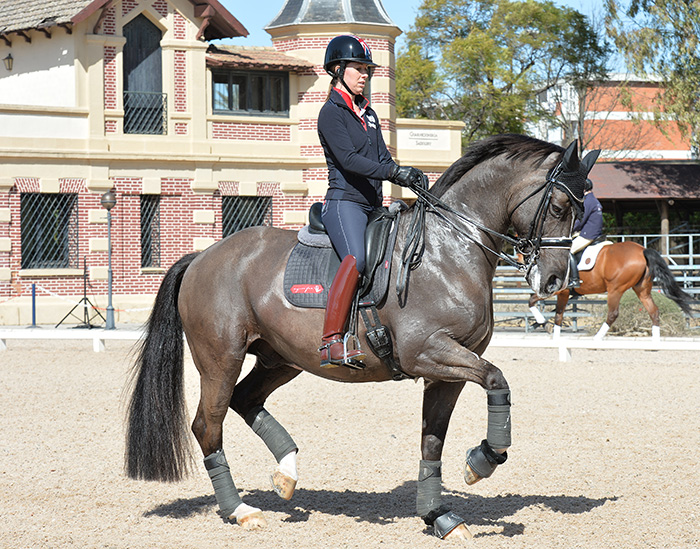
Piaffe:
Although the piaffe is still a diagonal movement, it lacks a true suspension phase. Piaffe is a movement of its own, but it is one of two doorways to the airs. As such, it is not an end in itself. It has to be dynamic, a movement to increase collection and weight shift to the rear end until the horse can tip in control all the way onto two hind legs. It is moving the center of mass further and further over the base of support of the hind the legs. It is really only the hind legs which have the power to lift and leap.
If the rider allows the piaffe to balance over the front legs, it takes less strength and misunderstands its purpose. When viewing the piaffe from behind, if the hind legs get narrower it is a tip off that the center of mass is shifting off the hind end and is most likely being supported by the front legs. This can occur if the trainer asks for too much activity behind and unknowingly moves the hind legs too far forward or up to high. If they are in the wrong place to carry weight, the game horse will move the base of support forward, setting off a number of problems of technique. Most importantly, it leaves the horse with no base of support to prepare a jump or lift, and the piaffe becomes counterfeit.
story continues below the advertisement
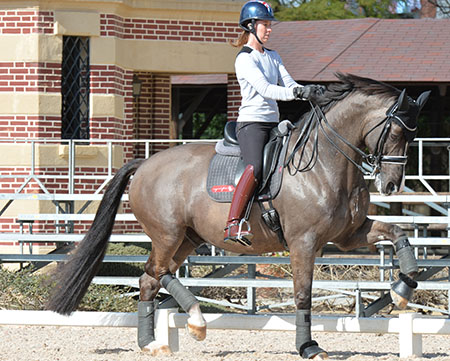
Passage:
The passage is an elongated forward moving piaffe. Past masters made it very clear that the passage should not advance so far that it becomes hollow with the hind legs following an upward generated force of the front legs, when the hind legs in fact should be governing it. The transitions from piaffe to passage and reverse can be a demonstration of fantastic strength and balance when the horse stays round and the legs don’t deviate much from their natural line of travel. For example, when there is insufficient strength in the core, the horse will twist axially, landing on legs that rotate under the body closer to the center of mass and bounce the movement up instead of lifting it from the normal stance.
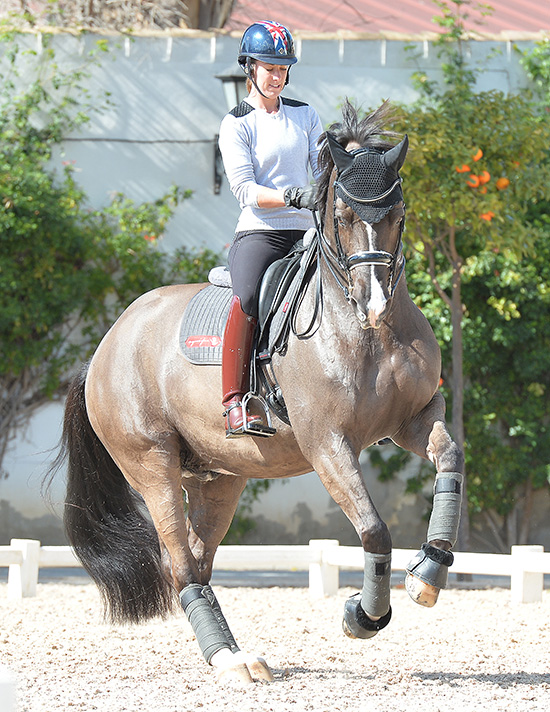
The Pirouette:
The collected canter and pirouette are to the canter what the piaffe is to the trot: some of the highest degree of weight shift and balance in that gait. The canter pirouette has to be considered the ultimate canter exercise. It is the smallest of circles a horse can make while remaining cantering. With virtually no forward advance, it requires complete collection of the stride and then, in successive canter bounds, with the hind legs practically on the same spot, it turns a complete 360 degree revolution until, from the same spot as its origin, the horse moves off forward or into a lateral movement with no apparent change in rhythm or tempo. When executed correctly, it is precise, powerful, and under such control that the rider should be able to interrupt it at any one of the six to eight strides, and ride off without hesitation.
The highly collected canter which can rock back and forth practically on the spot, is like the piaffe, a doorway to the airs. This rocking terre-a-terre, can be a more efficient way to set up some of the more explosive airs likes the courbette, the capriole, or ballotade, progressively loading the hindquarters more and more until the right moment, whereas the piaffe can be a perfect preparation for lightening the forehand more and more until it actually lifts off the ground into levade.
story continues below the advertisement
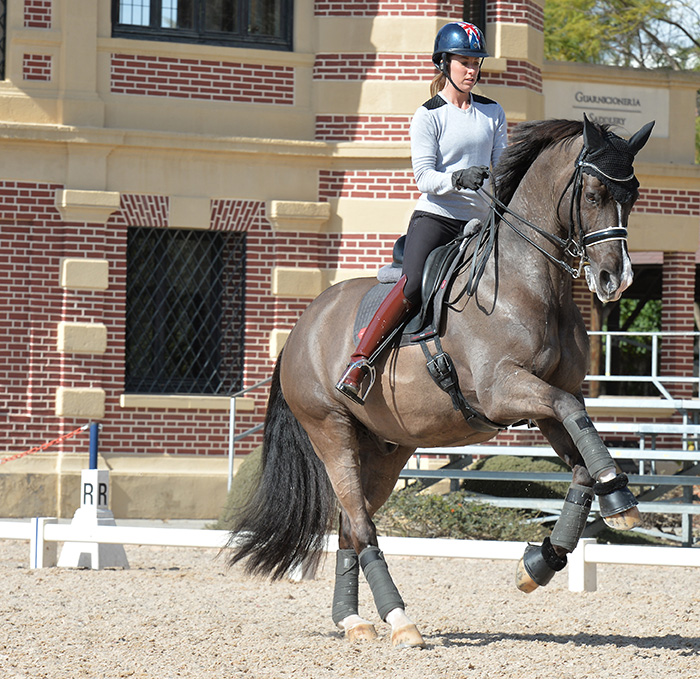
Flying Changes:
Flying changes can show great control of the sometimes emotional canter, when they can be controlled to a specific count and rhythm. They can show another level of dexterity and precision when they are executed straight, meaning not laterally swinging from change to change. The rider at one with the horse through the seat, with the hips married to the horse’s hips and not cueing the horse with the lower legs.
Extensions and collections in all gaits show control and power and in the case of the walk, calmness. They can expose anxiety or too much nervous tension.
Airs Above the Ground:
A trainer buys a young three year old. He is there as the horse is being loaded to ship to its new home, and as it walks to the edge of the ramp, it stops, hesitates to step onto the ramp. The trainer clucks, nudges it from behind. The horse raises one foot but doesn’t step onto the ramp. It raises the other leg and for a few seconds balances like a rabbit on its hind legs. Another attempt and the horse steps on. The trainer says nothing but he does not forget this, it may stay in his mind for five years or more.
At another barn, some young horses are being turned out. One young one just has come into training. He feels left out, its not his turn yet. Then he wheels around the stall, bucks once and kicks with both hind feet, hard into the wooden wall. There comes the stable manager’s strong admonishment. The trainer watching makes a mental note and stays out of it.
A third young horse gets excited, he has always been very suspicious of people, but he plays with a horse friend. He stands on his hind legs over and over, pushes his friend around, never seems to lose his balance.
Everything in high school is natural to the horses.
In the modern day in most activities, the training is so specific and takes so long that we live in an age of specialists. Very rarely can an elite performer show equally high skill in two domains at the highest level. Great scientists and great businessmen are not often great athletes, great doctors are not often great musicians. Even in a similar vein, great swimmers are not also great skiers.
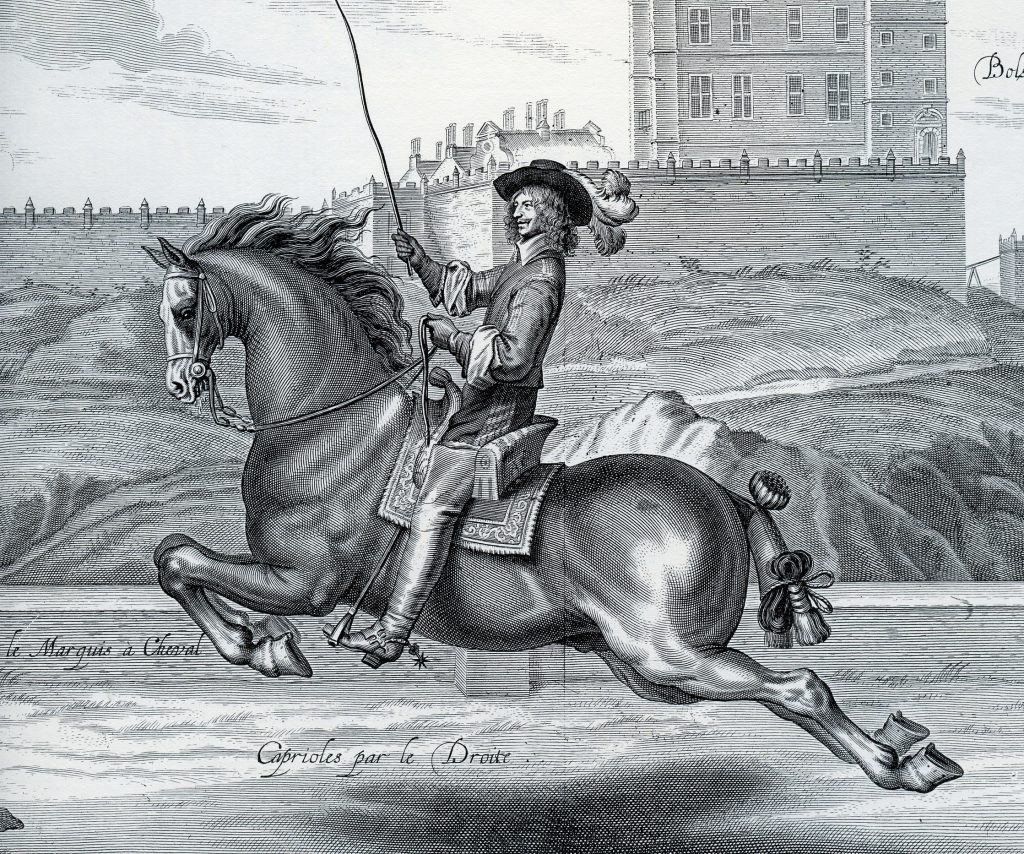
In the past there were many airs above the ground. The old masters seemed to love the jumps. These days they have evolved into a limited few: the levade, the capriole, the courbette, the ballotade. All the airs can be executed with or without a rider. They are often taught in hand. When they are ridden, these are one of the highest achievements of equestrianism.
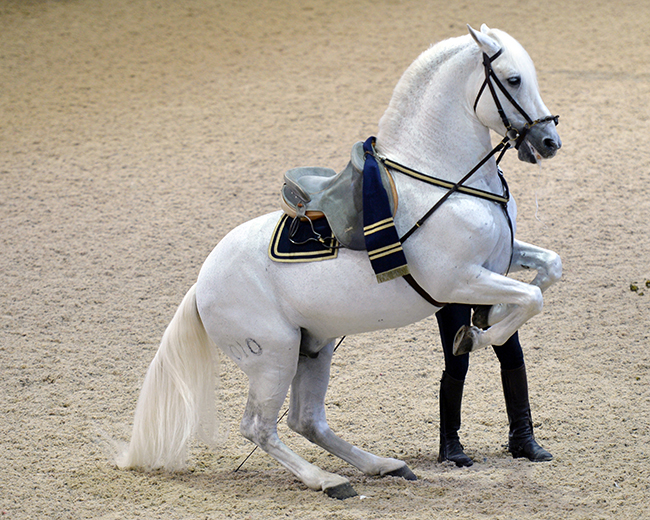
The levade is usually prepared from the piaffe. The piaffe is made to sit a little more and a little more until the horse lifts its front legs off the ground, symmetrically bringing them up and then balancing for several seconds deeply on the hind legs. To me the interesting thing is how universal the consciousness is, even among non-horsemen, of the preeminence of the image of levade. Not only are there countless paintings of it, there are porcelain pieces for individual shelves in individual houses, and great bronzes in city parts and squares. Its everywhere. Even in places where there are no more horses. It is an icon representing sustained power, balance, restraint, and taste. No one has to be beaten over the head with the statement, it is so obvious.
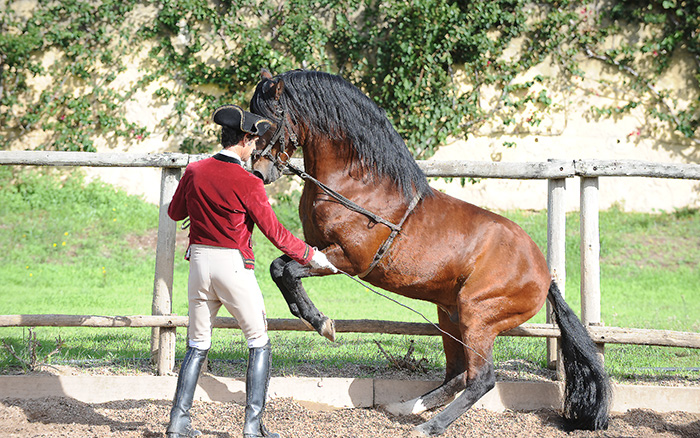
The courbette is canter or piaffe-based. The horse lifts back onto its hind legs, jumps almost straight up, landing back on its hind legs. When a horse and rider can execute multiple jumps without the front legs coming down, it is a demonstration of unbelievable strength and balance. Any imperfection in the footing, a rider in bad position, the smallest of mistakes could easily lead to a disaster.
The capriole is again piaffe or canter-based. The horse collects as much as it can, then like the courbette it jumps, but a little more forward, as in sport jumping. At the apex of the leap, it kicks out with both hind legs. It is very flamboyant, steeped in violence that is so controlled it becomes art.
The ballotade is very similar to a capriole without the kick. The horse leaps up with great power but keeps its legs tightly close to its body. It is a beautiful sibling to the previous airs.
Although some of the airs can be so difficult that the horses will specialize in a certain one, the training up to that point is universal. It must be complete, so that the airs are not short cut tricks. They are the result of a long road of discipline that allows now this freedom of high artistic expression, while limiting risk.
This training scale codifies the universal collaboration that overcame national rivalries and prepared a masterful body of evidence on how to train a dressage horse that can guide any thinking rider toward the future.
This series celebrates the launch of Paul Belasik’s latest project – a wall poster that chart the history and heritage of the classical tradition of dressage
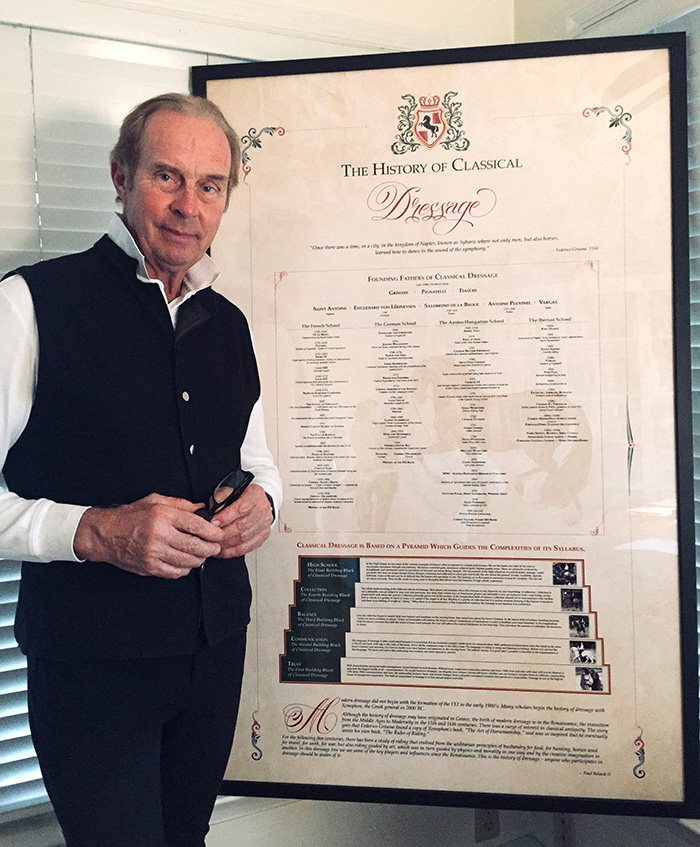
Iif you would like to order the poster:
https://paulbelasik.com/index.php/product/the-classical-training-scale-and-history-poster/
Did you miss the first article in this series? https://www.horsemagazine.com/thm/2020/10/paul-belasik-charts-the-heritage-of-dressage/

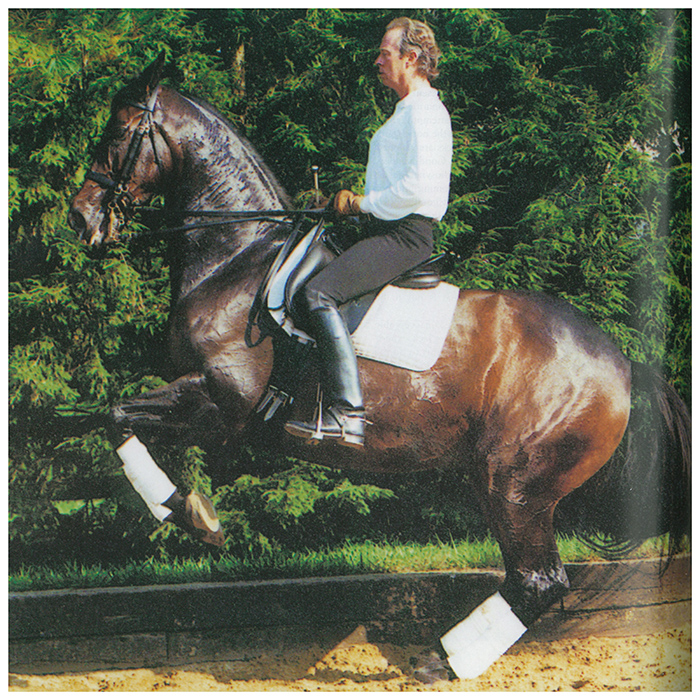
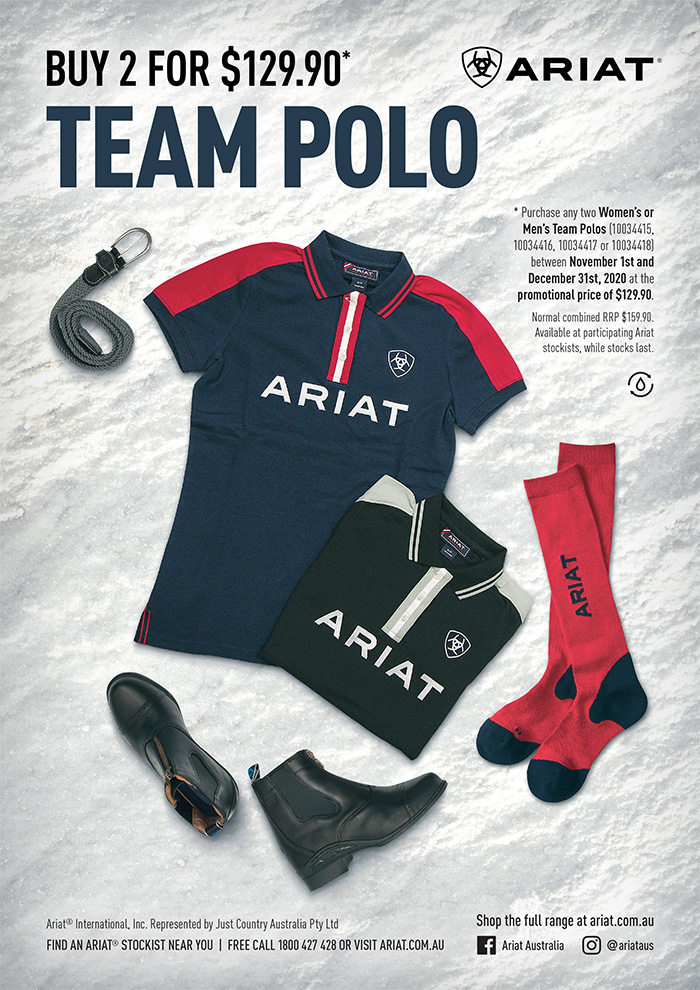
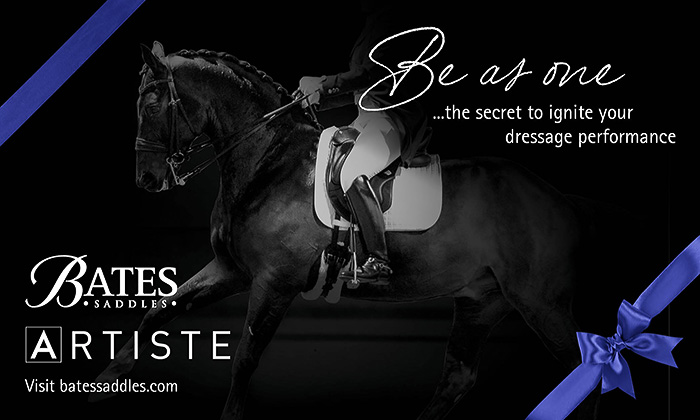

2 thoughts on “High School: The Final Building Block of Classical Dressage”
Comments are closed.